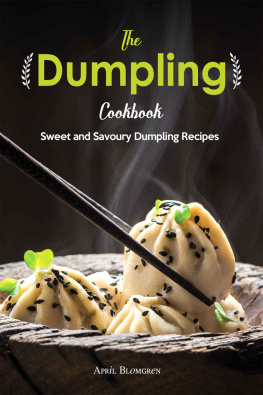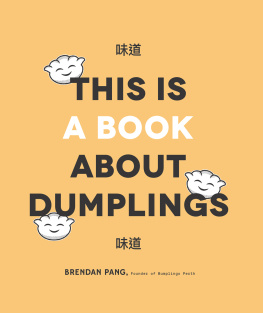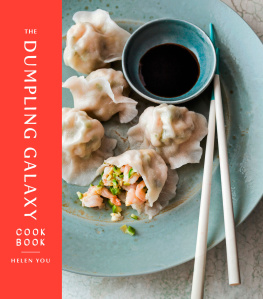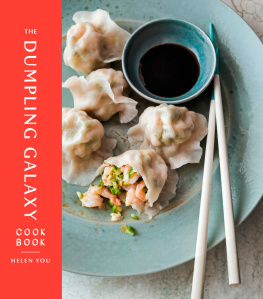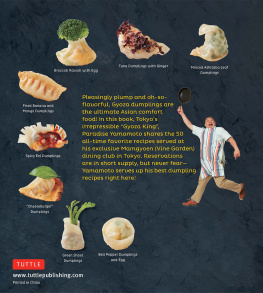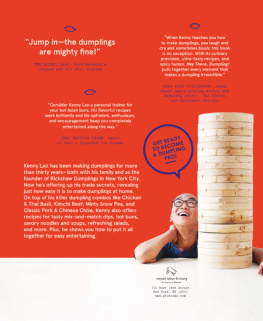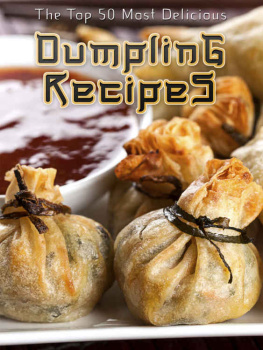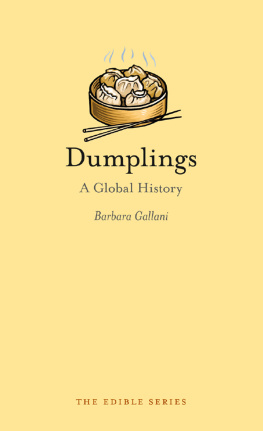Connie dedicates this book to her parents, John H. Lovatt and
Margaret H. Lovatt, and to her husband, Ravi Nandan

This book is about traditional dumplings and the simple pleasures they can bring into your kitchen.
Dumplings embody the foundations of good cooking: ingredients that make the most of the seasons, time-honored techniques, and an open mind. Because most dumplings are made by hand, they pull you deeper into the craft of cooking by emphasizing the value of intuition and the benefits of learning through trial and error.
Much as with recipes for bread, pastry, pasta and noodles, pancakes, biscuits, and cakes, traditional dumpling recipes create delicious mainstays loaded with character and charm. What we hope to demonstrate with this book is the reality that, despite their similarities to other dough- or batter-based creations, dumplings are in a category all their own.
So, what makes a dumpling a dumpling? Is an empanada a dumpling? Is a fritter? Every definition we have come across presents a slightly different view. After exploring a thousand different dishes normally considered to be dumplings, it became clear to us that their identities revolved around two key traits: They are made out of some kind of dough, batter, or starchy plant foundation, and they are either steamed, simmered, or boiled.
Its the use of wet heat that gets to the heart of what a dumpling really is, even if the basic ingredients are similar to what makes up bread, pastry, and pancakes. Baking, frying, and other dry-heat methods of cooking bestow a distinctive crust, rich with caramelized flavors. In contrast, the characteristic softness and clean taste that dumplings develop through wet heat cooking is what makes them so distinctive and special.
In this light, we do not see empanadas or fritters as true dumplings, even if they are occasionally referred to that way, because they are baked or fried. And while fish balls, meatballs, and cheese balls look like dumplings, and are prepared by similar methods, they are not included in this book because they are not primarily based on starchy ingredients.
While dumplings come in many forms, not just round or filled, they are not shaped as strands, or ribbons, as are pastas and noodles.
After working with hundreds of recipes for dumplings from around the world, our ideas of dumplings had expanded to include them in all their magnificent variety, and it also allowed us to refine our view into the following definition:
A dumpling is a portion of dough, batter, or starchy plant fare, solid or filled, that is cooked through wet heat, and is not a strand or ribbon.
We prepared dumplings from well over eight hundred recipes before compiling this collection. We envisioned the book to include not only American favorites such as chicken and dumplings and blueberry grunt but also dumplings from Europe, South America, and every other part of the world where dumplings are enjoyed. We wanted layered tapioca dumplings from Thailand and lavishly topped rice dumplings from Vietnam. We wanted Middle Eastern dumplings smothered in rich sauces and oil-slicked chickpea dumplings from India. We could not leave out stuffed plantain dumplings found only in Peru, or freshly pounded mochi from Japan, with its marshmallow bite and sticky texture.
We bring you dumplings that are hallmarks of particular regions or cuisines, such as the generously spiced Christmas pudding from England, the tamale from Mexico, and the hearty momo from Tibet.
Nor have we neglected dumplings like matzo balls and pierogi, which transcend their regional origins and are eaten around the world. Our recipes for favorites such as these are popular but lesser-known versions, not often included in many cookbooks.
The 135 dumplings that follow, and the 60 soups, stews, and sauces in which theyre cooked, are all traditionaladapted only as necessary for modern kitchen equipment and ingredients. You will find a detailed glossary of ingredients, equipment, tips, and diagrams to help simplify even the most demanding recipes. That being said, we strongly encourage you to use your hands, and not machines, when you roll out the dough that certain dumplings require. Of course, you can always use a pasta machine for dough that has to be rolled out thin, but using a rolling pin connects you more directly to the dough.
Our month-by-month arrangement of the recipes is based on our experiences and preferences and is not meant to be a fixed timeline. Certainly an August dumpling can be made in February, but we think you might find it to be at its most excellent in August. One reason is that many of our recipes feature seasonal ingredients that are best at their natural peak, even if they may be available year-round in your market. Some dumplings are especially suitable for certain months when the weather mimics the climate or traditional serving season of the dumplings home. Spicy dumplings from central Vietnam are great on hot days, while several rich dessert dumplings from England are best during the colder months. Of course, holiday dumplings are placed at the appropriate time of year.
Within each chapter, the recipes have been arranged in order from the easiest to the most challenging. The more demanding dumpling recipes require a degree of orderliness. Certain dumpling recipes have multiple components that must be prepared separately and then assembled together to create the final dish. Filling and folding several dozen dumplings is not a casual operation, but it can easily become a relaxing and enriching way to spend your time if your ingredients are sorted out, your workspace is clear, and you have allowed yourself plenty of time. No matter what your level of expertise is in the kitchen, we hope that these recipes will encourage you to try your hand at creating dumplings that are as enjoyable to make as they are to eat. There may be techniques and ingredients in this book that are unfamiliar to you, but this does not mean that you will not be able to understand them, apply what you already know as you work, and make a fantastic batch of dumplings.

This book is as much about quality ingredients as it is about dumplings. Shopping seasonally and as close as possible to the foods source ensures not only that youll go home with a better product but also that youll be more apt to support smaller, more sustainable farms. Farmers who provide their animals with a natural diet, and with plenty of light, air, and space, nurture not only the health of their animals but their customers health as well. The following ingredients either play a central role in this book or make occasional appearances but merit further description.
BEANS: Dried beans are simple and sturdy and can be made into satisfying dumplings at any time of year. Bean dumplings are usually made by grinding soaked dried beans into a pasty batter before cooking. In India, spoonfuls are fried before being simmered in stews and sauces. Other, similar batters are steamed in molds and pans. Canned beans are too soft to make into dumpling doughs and batters, but they are perfectly acceptable when added to soups, stews, and sauces. Be sure to rinse canned beans thoroughly before adding them to other ingredients. Some of the beans used in this book include kidney beans, cranberry (or borlotti ) beans, chickpeas, black-eyed peas, mung beans, and adzuki beans. Mung bean sprouts are also used in some Asian dumplings.


